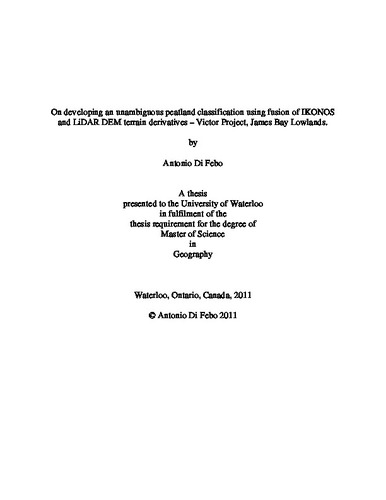| dc.description.abstract | Bogs and fens, which comprise > 90% of the landscape near the De Beers Victor diamond mine, 90 km west of Attawapiskat, ON, provide different hydrological functions in connecting water flow pathways to the regional drainage network. It is essential to define their distribution, area and arrangement to understand the impact of mine dewatering, which is expected to increase groundwater recharge. Classification was achieved by developing a technique that uses IKONOS satellite imagery coupled with LiDAR-derived DEM derivatives to identify peatland classes. A supervised maximum likelihood classification was performed on the 1 m resolution IKONOS Red/Green/Blue without the infrared (RGB) and with the infrared (IR_RGB) band to determine the overall accuracy prior to inclusion of the DEM derivatives. Confusion matrices indicated 62.9% and 65.8% overall accuracy for the RGB and IR_RGB, respectively. Terrain derivatives were computed from the DEM including slope, vertical distance to channel network (VDCN), deviation from mean elevation (DME), percentile (PER) and difference from mean elevation (DiME). These derivatives were computed at a local (15-cell grid size) and meso (250-cell grid size) scale to capture terrain morphology. The mesoscale 250-cell grid analysis produced the most accurate classifications for all derivatives. However, spectral confusion still occurred (regardless of scale) most frequently in the Fen Dense Conifer vs. Bog Dense Conifer classes and also in the Bog Lichen vs. Bog Lichen Conifer. Despite this confusion, by combining the larger scale LiDAR DEM derivatives and the IKONOS imagery it was found that the overall classification accuracy could be improved by 13%. Specifically, the DiME derivative combined with the multispectral IKONOS (IR_RGB) produced an overall accuracy of 76.5%, and increased to 83.7% when Bog Lichen and Bog Lichen Conifer were combined during a post hoc analysis. This classification revealed the landscape composition of the North Granny Creek subwatershed, which is divided into north and south. The north portion comprises 67.4% bog, 13.6% fen and 18.9% water class, while the south is 63.7% bog, 15.2% fen and 21.1% water class. These proportions provide insight into the hydrology of the landscape and are indicative of the storage and conveyance properties of the subwatershed based on the percentage of bog, fen, or open water. | en |

